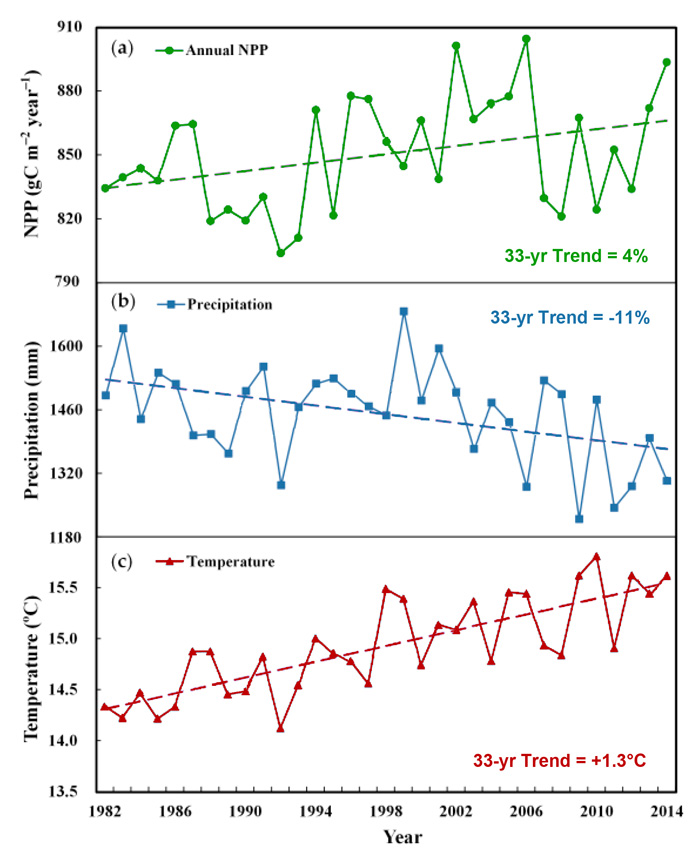| Tweet | Follow @co2science |
Paper Reviewed
Guan, X., Shen, H., Gan, W., Yang, G., Wang, L. Li, X. and Zhang, L. 2017. A 33-year NPP monitoring study in southwest China by the fusion of multi-source remote sensing and station data. Remote Sensing 9: 1082, doi:10.3390/rs9101082.
Climate alarmists frequently contend that the biosphere is fast going to hell in a hand-basket due to society's continued combustion of fossil fuels, which is raising the CO2 content of the atmosphere. Chief among their long list of concerns associated with this rise is the possibility of dangerous global warming, which warming they additionally claim will be accompanied by increases in the frequency and severity of extreme weather events such as floods and droughts, making the planet largely inhospitable for plants, animals and even humans to survive.
The scenario described above, although rooted in model projections of future climate some fifty to one hundred years or more into the future, leads many people to actually believe it is presently occurring. But is there any truth to this contention? Is there any real-world evidence to support claims of this disaster in the making?
A new paper by Guan et al. (2017) published in the journal Remote Sensing provides important insight into this topic. Using multiple sources of both ground and remotely-sensed data, the team of seven Chinese scientists analyzed trends in net primary productivity (NPP) in southwest China over the 33-year period from 1982 through 2014. NPP was selected as the key variable to study because it is an important indicator of the status of terrestrial ecosystems and can reveal whether an ecosystem is healthy or in decline, depending on whether or not it is gaining or losing carbon. So what did the seven researchers' analysis reveal?
Focusing in on the Yunnan province (21.13°-29.25°N and 97.52°-106.18°E), a mostly mountainous area covered with vegetation over 94% of its 394,000 km2 area, Guan et al. report that the mean annual trend in NPP for the entire province was positive over the entire length of record, increasing by 0.98 g C m-2 yr-1 (see Figure 1a, below). What makes this approximate 4% improvement/expansion in plant ecosystem health since 1982 so surprising, is the fact that it occurred despite a concomitant 1.3°C rise in temperature and an 11% decline in precipitation over the same period (see Figure 1b,c). Thus, either the vegetation in the Yunnan province, which ranges from topical to alpine species, is clearly not as sensitive to changes in temperature and precipitation as climate alarmists would have us believe, or something else (e.g., atmospheric CO2 fertilization) has enabled these plants to better cope with the increasing temperature and declining precipitation. Whatever the reason -- our money is on the CO2 fertilization effect, which is well documented to improve growth under rising temperatures and drought (see the many papers reviewed on this topic throughout our website) -- it is clear that the results of this real-world study not only fail to support climate-alarmist projections, they are in direct opposition to them. And while this news ought to help put even the most ardent of climate alarmists at ease, it will likely only enrage and cause them to further deny the very real truths that rising atmospheric CO2 is not causing, nor will it ever cause, dangerous global warming, and that CO2 is not a pollutant, but a necessary nutrient bestowing great benefits on the biosphere.

Figure 1. Inter-annual variation of (a) mean annual NPP, (b) annual accumulated precipitation and (c) annual mean temperature in Yunnan province from 1982 to 2014. The dashed lines represent the overall linear trends over the 33 years for each data set. Adapted from Guan et al. (2017).




